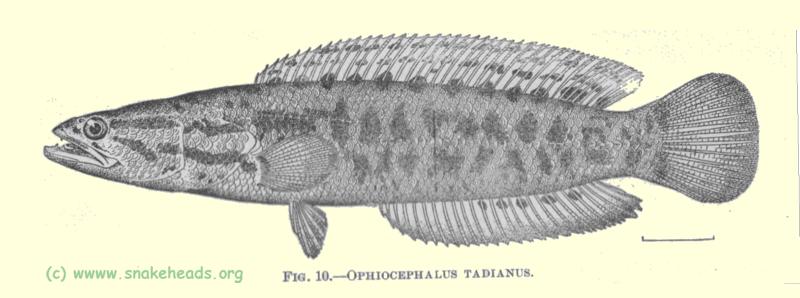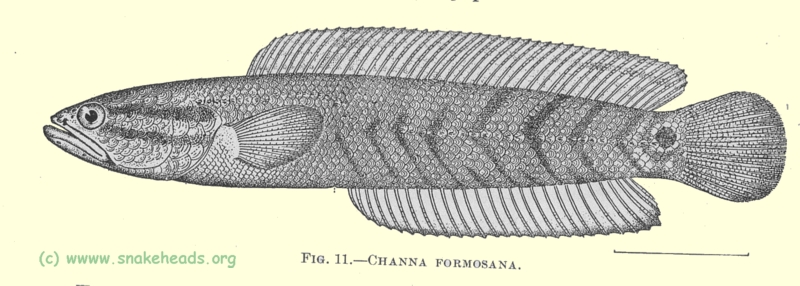
The island of Formosa is now part of the Japanese Empire. Beyond the general fact that its fauna must be similar to that of the neighboring coasts of China and the Philippines, scarcelyanything is known of its fishes. In the present paper is given the record of two collections made under Japanese auspices. The first was obtained by Mr. Tsunftsuke Tada, teacher in the Middle School at Osaka, for the Imperial University of Tokyo. The second was obtained by Japanese naval officers and others for a fisheries exhibit in Tokyo, and has been deposited in the Imperial Fisheries Institute or School of Fisheries of Tokyo. The latter collection was placed in our hands by Dr. Shinnosuke Matsubara, director of the Fisheries Institute. These specimens are without other locality than «Taiwan», and are apparently a series of the common market fishes of the port of Keerun (Keelung), the chief port of Formosa. This collection contains but few duplicates. The collection of Mr. Tada was made in six localities: Keerun, Taihoku, Giran, Toii, Suwata (Suwo Bay), Kotosho, and Hokoto. Taihoku is the capital of Formosa on the Tan Sin (fresh water) river. Keerun (Keelung) is its seaport at the north end of the island. Giran is a neighboring seaport to the eastward of Keerun. Toii and Suwata are near Giran. Hokoto, or Pescadores, is a large group of islands to the westward of Formosa; Kotosho a smaller group to the southeastward. Giran is about 50 miles to the westward of Ishigaki, in the Riukiu group. This collection is made up chiefly of small fishes, but among them are numerous duplicates, of which specimens have been placed in the United States National Museum and in the Museum of Stanford University.
The authors are indebted to Mr. Edmund ??eller for a preliminary identification of part of the collection, a piece of work which other duties have prevented him from completing. Important aid has also been given by Mr. Michitaro Sindo.
In the following list the specimens received from the Fisheries Institute without other locality than Taiwan (Formosa) and returned to that institution are marked F. 1. The specimens have mostly Japanese collectors' numbers, 1 x, 2 x, etc.; those not so provided were given numbers by us. These nunkbers, remaining attached to the specimens for purposes of identification, may serve as a convenience to future students in Japan. The following genera and species seem to be new to science:
Head 3; depth 4.75; eye 8.6; snout 6.2; maxillary 2.65, mandible 2.3; interorbital 5.3; D . 42; longest dorsal ray 3; A. 26; longest anal ray 2.7, ventrals 3.5; pectoral 2.3; scales 6-57-11. Body spindleshaped, compressed posteriorly, caudal peduncle short, deep and greatly compressed; head long and snake-like, covered with plate-like scales; eye small, anterior; nostrils wide apart, the anterior in a small tube on upper edge of maxillary; mouth oblique, large, the maxillary reaching past orbit; a band of small teeth on outer edge of jaws, a band of large, wide-set, canine teeth on palatines and inner side of lower jaw; upper jaw protractile; dorsal long, of numerous spinelike rays, low anteriorly, gradually lengthening posteriorly, caudal rounded; anal similar to dorsal, but not so long; ventrals very small and short, not reaching vent; pectoral short and rounded; lateral line broken anteriorly, running along center of body from base of caudal to just over second anal ray, thence upward for 2 rows of scales, then forward for 15 rows of scales, thence downward for 1 row, then forward to upper edge of gill-opening, where it ends. 1
 | O. tadianus by Jordan and Evermann. Today, science considers it as a synonym for C. maculata. This drawing is the probably the 2nd known of C. maculata as far as snakeheads.org knows |
General color in alcohol, olivacwous-brown above, lighter below; belly white, with some yellowish markings; a row of 12 dark olivaceous blotches along base of dorsal, partly on fin and partly oil body; below these but above lateral line another row of 8 or 1) shnilar but larger blotches, extending aitteriorly to the middle of tipward curve in lateral line; below this another linc of about 1:1 lighter colored and very irregular -blotches, extending from base of pectoral posteriorly along lower edge of lateral line to base of caudal, below this another line of scattered and faint blotches from lower edge of pectoral to posterior end of anal; head color of upper part of body, but streaked with irregular lines of black above; a line of light dusky, as wide as pupil, but becoming nearly as broad as eye at edge of opercle, running from posterior edge of eye to base of pectoral, its lower edge just b~low upper base of pectoral, below this all irregular line of light brown-olivaceous slightly wider than pupil, running to middle of base of pectoral; head below this pale; dorsal with 2 broken stripes of brown-olivaceous about as wide as pupil; caudal membranes dark, rays pale brown-olivaceous, anal with indications of 4 or 5 dark blotches at the base of posterior half, rest of fin pale at base, becoming darker, almost brown-olivaceous toward tips; ventrals pale, dusky; pectoral slightly darker than ventrals.
Type .- No. 3xx, a specimen 9.5 inches long, from Formosa, returned to the Imperial Fisheries Institute.
Head 3.6; depth 5.75; eye 5.75; snout 5.25; maxillary 2.5; mandible 2.25; interorbital 3.5; D. 44; A. 28; scales 4-54-13. Body moderately long and slender, much compressed posteriorly; head large, broad, depressed and snake-like; mouth large, oblique, the lower jaw slightly projecting, the maxillary reaching posterior edge of orbit; teeth cardiform, in both jaws and on vomer; eye moderate; caudal peduncle short, very deep and very much compressed. Scales large, plate-like, each with strong concentric striae; lateral line very irregular, beginning above opercular opening, extending backward on 7 scales, then running for 8 scales on next row above, then dropping irregularly for 3 or 4 rows over origin of anal, thence continued along median line of side to base of caudal fill. Dorsal fin long, beginning over base of pectoral, the rays quite uniform in length, the last being somewhat longest, being about 2.5 in head; anal similar to dorsal, but shorter, beginning under about the twelfth dorsal ray and ceasing under the last dorsal ray but two; rays of dorsal and anal all unbranched, but articulated; pectoral short and broad, its tip reaching vent; ventrals absent, caudal broad and rounded. 1
 | C. formosana by Jordan and Evermann. Today, science considers it as a synonym for C. asiatica one of the many synonyms of C. asiatica. |
Color in alcohol, yellowish-brown, the side with about 8 V-shaped imbricated dark crossbars, the apex pointing forward; these crossbars plainest posteriorly, more or less broken and irregular in f ront; a large, round, black ocellus on caudal peduncle, at base of caudal fin as large as eye, bordered by white; side of head with two broad, (lark bars extending from eve to posterior edge of opercle; dorsal fin punetulate but with about 2 series of rather distinct whitespots on the membrane, extending nearly full length of fin; anal fin plain, somewhat dusky at edge; caudal and pectoral pale, slightly punctulate.
Type . --No. 5075, a specimen 5.25 inches long, from Sowo or Suwata, Formosa, now numbered 7132 Stanford University Museum; others, No. 269, are from Suwata.
[ ... ]
It is evident that these collections comprise but a small part of the fish fauna of Formosa, being in fact chiefly made tip of the common market fishes. The gobies and blennies, especially abundant in this region, are almost unrepresented, while the equally abundant Callionymidae are wanting altogether. The scant representation of Labridae , Holocentrida Scorpionidae shows that no effort was made to secure the fishes of the coral reefs, and doubtless many of the, commonest species were overlooked or rejected by the collectors. Yet with all this, the collections give a fair understanding of the fishes of Formosa. It is evident in the first place that the marine species are essentially those of that part of the coast of China having similar physical conditions. The freshwater fishes are derived from China, but are largely distinct as to species. Compared with Japan and India, the following statistics may be interesting:
| Species common to Formosa and Kiusiu | 30 |
| Species common to Formosa and Hindostan | 77 |
| Species common to Formosa, Kiusiu, and Hindostan | 37 |
It is evident that the faunal relations of Formosa are closer with those of Hindostan than with even the southernmost of the Japanese islands, Kiusiu. As for the main island of Japan (Hondo), few of its characteristic species extend their range south of the Tropic of Cancer; and few of them reach even to the Riukiu Archipelago.
[ ... ]
1 Ophicephalus tadianus is a synonym for Channa maculata (Lacepede, 1802) . [snakeheads.org]. Back
2 Channa formosana is a synonym for Channa asiatica (Linne, 1758) . [snakeheads.org]. Back
These passages were originally published under the above title in: Proceedings of the United States National Museum . Vol. 25, pp. 315-368, 1903.
| © 2001 - 2004 snakeheads.org | HOME of this page |